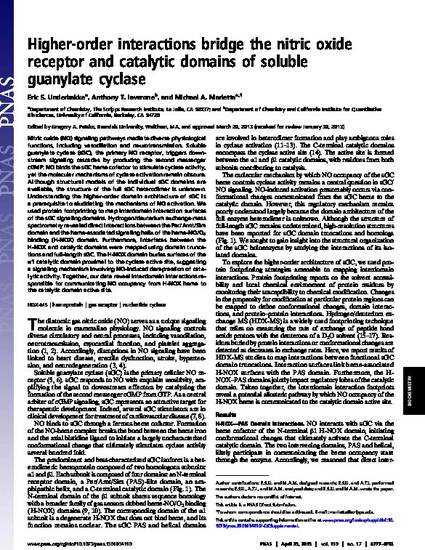
Article
Higher-order interactions bridge the nitric oxide receptor and catalytic domains of soluble guanylate cyclase
Proceedings of the National Academy of Sciences
(2013)
Abstract
Nitric oxide (NO) signaling pathways mediate diverse physiological functions, including vasodilation and neurotransmission. Soluble guanylate cyclase (sGC), the primary NO receptor, triggers downstream signaling cascades by producing the second messenger cGMP. NO binds the sGC heme cofactor to stimulate cyclase activity, yet the molecular mechanisms of cyclase activation remain obscure. Although structural models of the individual sGC domains are available, the structure of the full sGC heterodimer is unknown. Understanding the higher-order domain architecture of sGC is a prerequisite to elucidating the mechanisms of NO activation. We used protein footprinting to map interdomain interaction surfaces of the sGC signaling domains. Hydrogen/deuterium exchange mass spectrometry revealed direct interactions between the Per/Arnt/Sim domain and the heme-associated signaling helix of the heme-NO/O2 binding (H-NOX) domain. Furthermore, interfaces between the H-NOX and catalytic domains were mapped using domain truncations and full-length sGC. The H-NOX domain buries surfaces of the α1 catalytic domain proximal to the cyclase active site, suggesting a signaling mechanism involving NO-induced derepression of catalytic activity. Together, our data reveal interdomain interactions responsible for communicating NO occupancy from H-NOX heme to the catalytic domain active site.
Keywords
- HDX-MS,
- hemoprotein,
- gas receptor,
- nucleotide cyclase
Disciplines
Publication Date
2013
DOI
10.1073/pnas.1301934110
Publisher Statement
Copyright 2013 National Academy of Sciences
Citation Information
Eric S. Underbakke, Anthony T. Iavarone and Michael A. Marletta. "Higher-order interactions bridge the nitric oxide receptor and catalytic domains of soluble guanylate cyclase" Proceedings of the National Academy of Sciences Vol. 110 Iss. 17 (2013) p. 6777 - 6782 Available at: http://works.bepress.com/eric-underbakke/3/
